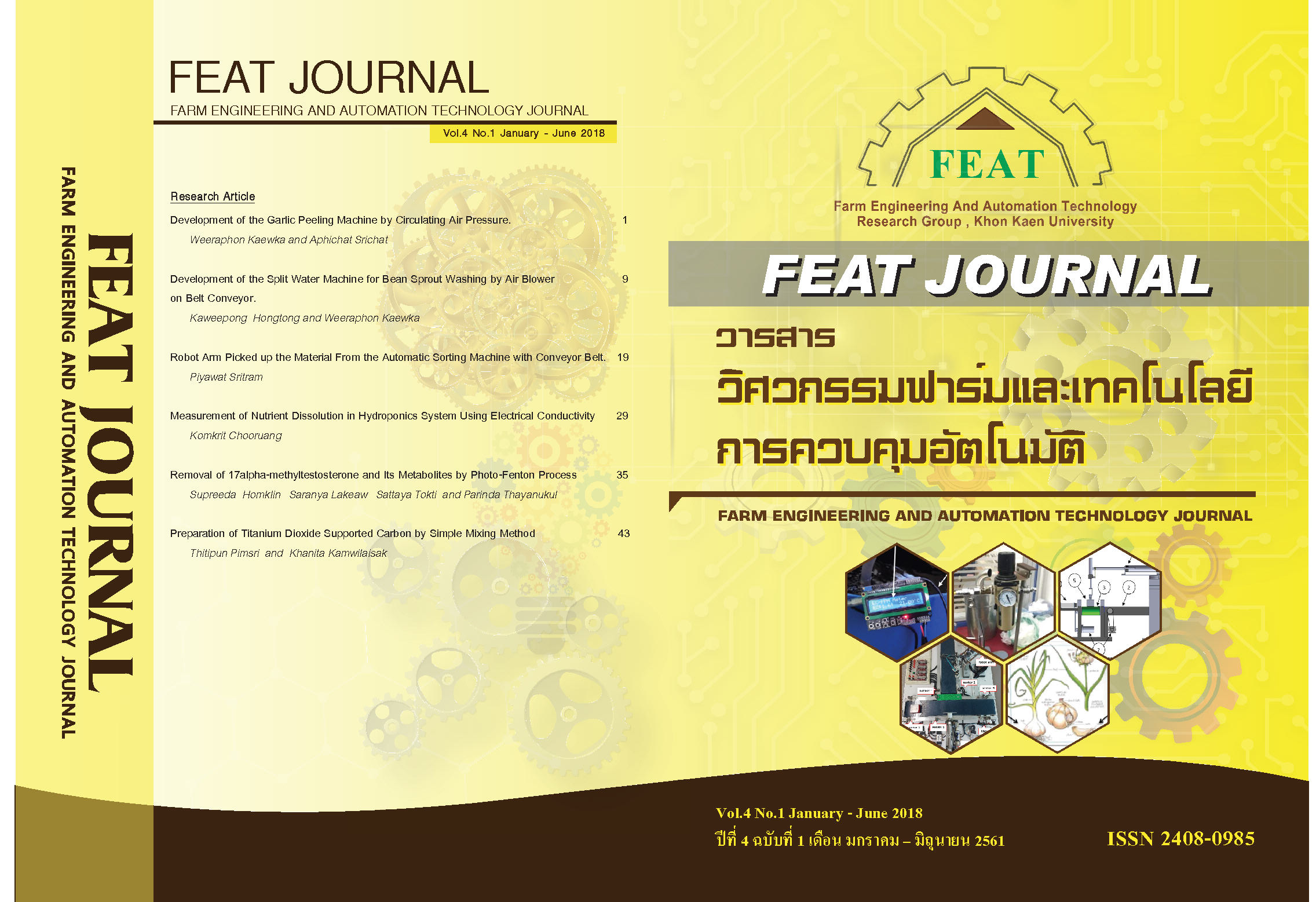Removal of 17alpha-methyltestosterone and Its Metabolites by Photo-Fenton Process
Main Article Content
บทคัดย่อ
17alpha-methytestosterone (MT) has been used as a synthetic androgenic hormone to induce male population in Nile tilapia fry by feeding the MT at 60 mg/kg. The effluent wastewater containing residue MT from masculinizing ponds without any treatment may effect on the endocrine system of exposed human and wildlife. The MT is classified as an endocrine disrupting compound. Thus, this research aims to study the efficiency of MT removal by Photo-Fenton and the effect of initial MT concentration and dissolved organic carbon (DOC) on the removal efficiency. The result showed that the optimal pH, amount of ferric iron, and ratio of Fe2+:H2O2 of Photo-Fenton process was 3, 0.003 mM, and 1:100 (mM:mM), respectively. The degradation rate constant decreased with the increasing of the initial MT concentration because of the limitation of hydroxyl radical generation. The DOC could inhibit the MT removal in the first 40 min due to the competition between the existing organic compounds. However, MT did not undergo mineralization as the DOC was not significantly decreased.
Article Details
วารสารวิศวกรรมฟาร์มและเทคโนโลยีควบคุมอัตโนมัติ (FEAT Journal) มีกําหนดออกเป็นราย 6 เดือน คือ มกราคม - มิถุนายน และกรกฎาคม - ธันวาคม ของทุกปี จัดพิมพ์โดยกลุ่มวิจัยวิศวกรรมฟาร์มและเทคโนโลยีควบคุมอัตโนมัติ คณะวิศวกรรมศาสตร์มหาวิทยาลัยขอนแก่น เพื่อเป็นการส่งเสริมและเผยแพร่ความรู้ ผลงานทางวิชาการ งานวิจัยทางด้านวิศวกรรมศาสตร์และเทคโนโลยีพร้อมทั้งยังจัดส่ง เผยแพร่ตามสถาบันการศึกษาต่างๆ ในประเทศด้วย บทความที่ตีพิมพ์ลงในวารสาร FEAT ทุกบทความนั้นจะต้องผ่านความเห็นชอบจากผู้ทรงคุณวุฒิในสาขาที่เกี่ยวข้องและสงวนสิทธิ์ ตาม พ.ร.บ. ลิขสิทธิ์ พ.ศ. 2535
เอกสารอ้างอิง
[2] Selzsam B, et al. Effects of methyltestosterone on reproduction in the Japanese quail (Coturnix coturnix japonica). Environmental Research 2005; 99: 327–34.
[3] Oehlmann S.U, et al. Effects of ethyloestradiol and methyltestosterone in prosobranch snails. In: Kümmerer K, editor. Pharmaceuticals in the environment. Sources, Fate, Effects and Risk. 2nd ed. Berlin, Heidelberg: Springer-verlag; 2004: 233-47.
[4] Homklin S. Biodegradation of 17alpha-methyltestosterone by microorganisms in sediment from masculinizing pond of Nile Tilapia fry. [Dissertation]. Bangkok, Chulalongkorn University; 2009.
[5] Sagulsawasdipan K. Degradation of 17α-methyltestosterone by ultraviolet radiation. [Master thesis]. Bangkok, Chulalongkorn University; 2012.
[6] Sun J.H, et al. Oxidative decomposition of p-nitroaniline in water by solar photo-Fenton advanced oxidation process. Journal of hazardous material; 2008; 153: 187-93.
[7] Mendez-Arriaga, F., Esplugas, S. and Gimenez, J. (2010). Degradation of the emerging contaminant ibuprofen in water by photo-Fenton. Water research. 44, 589–595.
[8] Kajitvichyanukul P, et al. Formaldehyde degradation in the presence of methanol by photo-Fenton process. Journal of Environmental Management; 2008; 86: 545–53.
[9] Tamimi M, et al. Methomyl degradation in aqueous solutions by Fenton’s reagent and the photo-Fenton system. Separation and Purification Technology; 2008; 61: 103–8.
[10] Jeong J, Yoon J. pH effect on OH radical production in photo/ferroxalate system. Waste Research; 2005; 39: 2893-2900.
[11] Meric S, et al. Color and COD removal from wastewater containing Reactive Black 5 using Fenton’s oxidation process. Chemosphere; 2004; 54: 435-41.
[12] Xu M, et al. Removal of organic carbon from wastepaper pulp effluent by lab-scale solar photo-Fenton process. Journal of Hazardous Materials; 2007; 148: 103-9.
[13] Lee H, Shoda M. Removal of COD and color from livestock wastewater by the Fenton method. Journal of Hazardous Materials; 2008; 153: 1314-9.
[14] Malik P.K., Saha S.K. Oxidation of direct dyes with hydrogen peroxide using ferrous ion as catalyst. Separation and Purification Technology; 2003; 31: 241-50.
[15] Papadopoulos A.E, et al. Development and optimization of dark Fenton oxidation for the treatment of textile wastewaters with high organic load. Journal of Hazardous Materials; 2007; 146: 558-63.
[16] Wongniramaikul W, et al. Diisobutyl phthalatedegradation by Fenton treatment. Journal of Environmental Science and Health; 2007; 42: 567-72.
[17] Hu X, et al. Transformation and reduction of androgenic activity of 17 α -methyltestosterone in Fe3O4/MWCNTs–H2O2 system. Applied Catalysis B: Environmental: 2012; 127: 167– 17.


